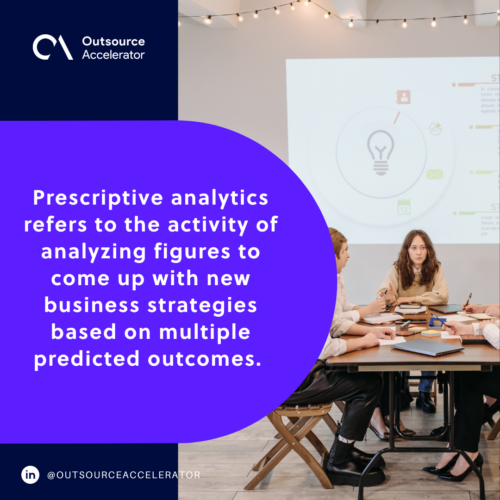Prescriptive analytics
Definition
nfluence outcomes.
Both predictive and prescriptive models play crucial roles in leveraging data for strategic decision-making in various industries.
Along with descriptive analytics and predictive analytics, the process equips business analysts with the necessary data and tools to gain meaningful business insights.
Moreover, diagnostic analytics serves as a crucial precursor to prescriptive analysis by uncovering the root causes and factors behind historical data patterns. It involves a deep analysis of past events, identifying why certain outcomes occurred.
This understanding gained from diagnostic analytics forms the foundation for prescriptive analytics. It enables it to recommend the most effective actions based on a comprehensive comprehension of historical data and contributing factors.
In essence, diagnostic analytics illuminates the “why” behind data trends, empowering prescriptive analytics models to offer informed guidance for optimal decision-making.

The purpose of prescriptive analytics
Prescriptive analysis has three general purposes that strengthen its role in business analytics.
To determine a course of action
With present figures and historical data, the process focuses on providing solutions and the necessary information on what the company should do next.
Business intelligence (BI) specialists who are experts in this kind of prescriptive analysis often have several ways to conceive solutions that will benefit the company in the long run.
To maximize available resources
Prescriptive analytics helps companies to come up with solutions that maximize their available resources.
By doing so, they are not only being cost-effective but also ensuring that they exhaust all possible options. Incremental analysis also comes into play here.
To facilitate and stimulate growth
With proper analysis, BI specialists and analysts can stimulate growth by showcasing what could happen if the business were to take the options they were presented with.
Using the tools and the figures they have, business users can explore various choices and different approaches.
Enhancing the effectiveness of prescriptive analytics
Prescriptive analytics is closely connected with both machine learning (ML) and artificial intelligence (AI).
Prescriptive analytics utilizes advanced machine learning algorithms to analyze historical and real-time data, aiming to recommend optimal actions.
Machine learning, being a part of AI, enhances this process by allowing systems to learn from data patterns, identify trends, and continually refine their predictive capabilities. There are already prescriptive analytics tools that accomplish this.
The adaptability and self-learning nature of ML algorithms empower prescriptive analytics to make more accurate and personalized recommendations over time.
In essence, the synergy between prescriptive analytics, machine learning, and artificial intelligence techniques lets organizations harness the power of data-driven insights to make informed decisions and optimize outcomes.
It’s a collaborative relationship where the sophistication of machine learning algorithms enriches the prescriptive analytics process.
Industries that utilize prescriptive analytics
Most companies use prescriptive analytics to get the most out of their options. However, certain industries use this kind of data analysis more than others.
Retail
In the retail industry, data study is a normal yet important part of their business stratification. Each target market has different subsets that need to be analyzed; otherwise, the company may miss a whole demographic of customers.
Finance
Investment banks, fintech companies, and traditional financial institutions utilize every kind of data analytics.
Given that they handle sensitive information and generally serve as the backbone of corporations, they need to address areas of improvement as soon as possible.
Technology and telecommunications
The tech industry is a sprawling sector that often sets trends for others to follow. With that massive play of power, they need to be on top of the movement.
This is one of the reasons why they utilize prescriptive and predictive analytics to its fruition.







 Independent
Independent




